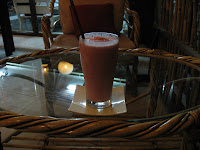I decided it was time to leave Luang Prabang, so I went to the Laos Airways building just outside town, bought a flight to Chiang Mai, and was on my way that afternoon. It's nice how you can do that kind of spur-of-the-moment travel here. There are travel agencies, both third party and for the travel companies themselves. There seems to be a standard price plus small arrangement fee which does not fluctuate depending on day of the week or how far in advance you purchase. So you can be quite spontaneous in your travel.
I had been told that Thailand has a great tourist infrastructure, and when I arrived in Chiang Mai I began to understand what this means. Prices are displayed, so you don't have to haggle and you don't feel like you're getting ripped off. A thirty day visa is free for many nationalities (including U.S.), and there is no need to apply in advance. It is legal for foreigners to drive motorbikes and cars, unlike some neighboring countries. More often restaurants will have English menus, staff that speak passable English, and food more appealing to a western palette. Things are almost as cheap as Laos and Vietnam, and the food is delicious. Here's a meal of sticky rice, Thai iced tea, and vegetable curry, and another of vegetable fried rice:


I had a quiet few days in Chiang Mai, slowly exploring the city filled with Buddhist temples and with a square old city surrounded by walls and a moat. I spent a lot of time relaxing at my comfortable guesthouse with friendly staff that spoke some English, and took many of my meals at the guesthouse restaurant. Many guesthouses have attached restaurants and will arrange outings for you, both of which strongly supplement their income. My guesthouse happened to have an excellent and friendly cook, so I enjoyed some Thai meals like cashew chicken and some American ones like french toast.



My first morning in Chiang Mai, I had breakfast at a nearby cafe. It was a nice husband-wife operation, and they made their own jam. The only other patrons were a 60-year-old white man and a 17-year-old, beautiful Thai girl eating together. Prostitution is legal in Thailand, and there was plenty of it going on in Chiang Mai. I bet it makes up a good part of the tourist industry income. I had seen this kind of open prostitution before in Amsterdam, but it's even worse when you have comparatively rich men making use of comparatively poor women / girls, and already a sense of servitude permeates the tourism industry.
I'm finding that, even though these cities have somewhat repulsively tourist-oriented areas, they have plenty of their own identity elsewhere. Even in tiny Luang Prabang, you could walk a little ways and find Lao people doing their own thing.
I had started to feel an urge for some adventure, so I began to research renting a motorbike for a multi-day trip from Chiang Mai on my own. I had read that the mountains of northwest Thailand were great for motorbiking and the roads well-paved and fairly safe. I found a few good maps of the area, one that had guesthouses and sites marked on it.
So on my fourth day in Chiang Mai, I rented a 125CC Honda Dream (four speeds and manual transmission, but no clutch) for 200 bat ($7) per day, which included comprehensive insurance. I chose the bike because it was very similar to Laura's that I had ridden in Hanoi, but with slightly more power to help with getting up the mountains I'd be riding in. I took it on a test ride to the nearby Phayap University, where I would play another game of pickup ultimate, like I did in Hanoi, the next day. Near the fields, there was a cluster of stores and restaurants catering to the University where I got a delicious strawberry shake at a comfy coffee shop and read my book for a while.

On my last day in Chiang Mai, I did a longer practice motorbike trip to the mountain temple Wat Phrathat Doi Suthep, about 45 minutes ride from my guesthouse and with lots of twists and turns. There was a long stairwell up to the temple (or a funicular tram if you preferred), which was beautiful and full of tourists, both Thai and foreign.



The ultimate was good fun and great exercise, and surprisingly similar to Hanoi though with fewer locals and no smog. I had another yummy dinner, this time of Panang curry, at a cooking school and restaurant around the corner from my guesthouse.


Another morning, I followed a Lonely Planet walking tour of wats (and the wat dogs) in the old, moated city. I had delicious lunch of pad thai and pineapple shake, and after my meal had a conversation in English with my waitress and her mother who ran the place together. I was reminded that an interesting thing to do would be to get to know a waiter or waitress, and then ask to hang out with them and their friends after work, as a way to see a slice of the local culture. The cook at my guesthouse made such an offer to me after I had stayed there for a few nights, though I didn't take him up on it because I had to pack for an early departure the next day for my motorbike adventure.












































